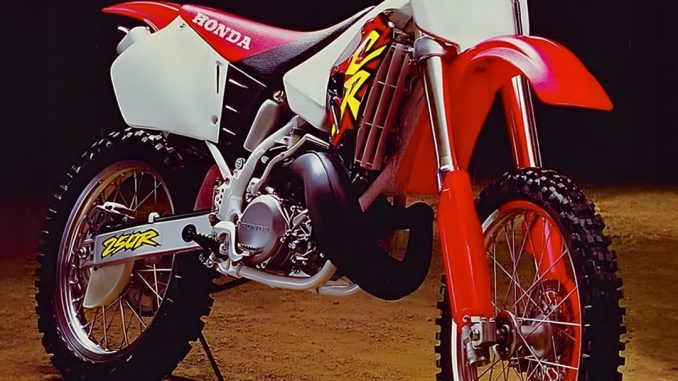
When the conversation turns to motocross legends, only a handful of machines draw almost universal admiration. Among them, the 1996 Honda CR250R holds a special place in history. Regarded by many as the last truly great two-stroke 250 from Honda, it represents the final chapter of the steel-framed era before the Japanese giant shifted to aluminium chassis designs. For riders and restorers alike, the ’96 model stands as a benchmark of performance, craftsmanship, and racing heritage.
The Last of Its Kind
By the mid-1990s, Honda had already built a formidable reputation with the CR250 lineage, dating back to 1973 when the brand first became a serious contender in motocross. Throughout the 1980s and early ’90s, the CR250R was synonymous with speed and championships, carrying the likes of Rick Johnson, Jeff Stanton, and later Jeremy McGrath to domination in AMA Supercross and Motocross.
But 1996 was unique. It was the final year Honda produced its quarter-litre racer with a steel frame—a tried-and-tested platform beloved by riders for its balance, predictability, and classic feel. From 1997 onward, aluminium frames became the new standard, forever altering the character of the CR250R. While innovation is the lifeblood of motocross, many purists agree: Honda’s last steel-framed CR was the pinnacle of refinement before change.
Subtle but Smart Refinements
Unlike some model years that bring sweeping changes, Honda knew the 1995 machine was already a class leader. For 1996, the refinements were subtle but significant. The purple graphics of the mid-’90s gave way to a sharper red-and-black “factory look,” reflecting the aggressive design cues of the brand’s works bikes. Under the skin, a revised Kayaba front fork improved handling precision, while updates to ignition mapping, carburetion, and gear ratios delivered sharper throttle response and more usable power.
At its heart was the CR’s celebrated 249cc two-stroke engine. Fast, reliable, and versatile, it produced the kind of powerband riders loved—explosive enough to win races but broad enough to inspire confidence over long motos. Compared to some rivals, Honda’s suspension was seen as slightly less forgiving, but in the hands of a skilled rider, the combination of motor, chassis, and build quality made it the ultimate race weapon.
A Racing Icon
The 1996 CR250R’s reputation wasn’t built on spec sheets alone. It became inseparable from two of the sport’s biggest names. Jeremy McGrath, at the height of his Supercross dominance, showcased just how lethal the bike could be indoors, carving through stadium circuits with unmatched precision. Meanwhile, Stefan Everts carried the CR to World Motocross glory in Europe, proving its capability on vastly different terrain. The machine’s global success cemented its status as a true all-rounder.
Built to Last
Honda’s attention to detail set the CR apart from its competition. Everything—from plastics and fasteners to engine components—was built with durability in mind. Riders quickly learned these bikes weren’t just fast; they were dependable, capable of withstanding punishing race schedules without constant breakdowns. That build quality explains why so many examples of the ’96 CR250R remain on tracks and in collections today. It’s not just nostalgia keeping them alive—it’s craftsmanship.
The End of an Era
When Honda introduced its aluminium frame in 1997, the motocross world changed. The new chassis was lighter and stiffer but altered the feel of the bike dramatically. Some riders embraced it, while others longed for the forgiving, predictable character of the steel frame. Ironically, decades later, several manufacturers returned to steel-frame designs for their race bikes, proving the timeless appeal of the material Honda left behind.
For collectors and enthusiasts, the 1996 CR250R has become a “holy grail” machine. It represents the zenith of two-stroke development before motocross entered a new age dominated by four-strokes and fuel injection. Owning one isn’t just about reliving history—it’s about preserving a piece of motocross DNA.
Steel Survivor
Today, the ’96 Honda CR250R is revered as a survivor of a golden era—an era defined by high-revving two-strokes, premix in the air, and racing stripped down to its purest form. Whether it’s restored to showroom condition or kept running as a weekend track weapon, it deserves to be ridden, not just displayed.
For those lucky enough to own or restore one, keeping the machine alive is easier than ever. CMSNL offers the world’s largest stock of genuine vintage Honda parts, ready to ship worldwide. From plastics to pistons, everything needed to bring a steel-framed CR back to glory is available to ensure this legend continues roaring for years to come.
The 1996 Honda CR250R isn’t just a motorcycle—it’s the last of its kind. A steel-framed survivor that captured the essence of motocross and left a legacy that still resonates nearly three decades later.
Word count: ~706 ✅
Would you like me to also format this into a press-release style PDF (with images, bold subheadings, and clean layout), so it reads like a professional motorsports magazine feature?
Leave a Reply